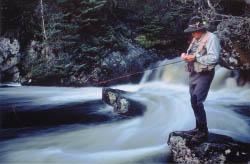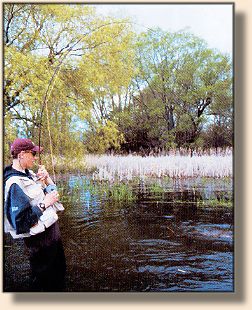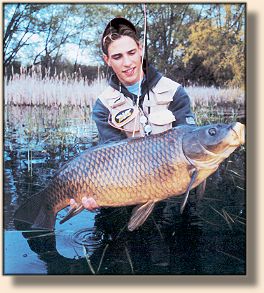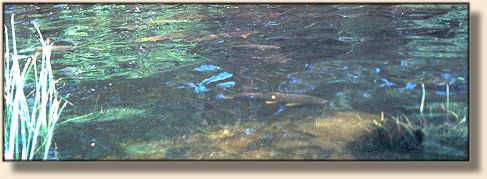Stalking Spring Carp, Part 2

By Chris Marshall
Gear
 This is no delicate business. Leave your trout gear at home.
What you need is a heavy-duty #9 or #10 weight rod, at least
nine feet long, with a fighting butt. I use a ten-foot rod
with a WF9 floating line - the same rod I use for chinooks.
The extra length makes it easier to maneuver the line among
the cattails without fouling it. It's perfect for making
the short flip casts, which are what most situations demand.
You have to be close to the fish in order to see them take.
Carp are so quick to spit out an artificial fly, that the
usual method of watching for the leader to twitch is useless.
Most of the time the leader never even moves when a fish takes.
This is no delicate business. Leave your trout gear at home.
What you need is a heavy-duty #9 or #10 weight rod, at least
nine feet long, with a fighting butt. I use a ten-foot rod
with a WF9 floating line - the same rod I use for chinooks.
The extra length makes it easier to maneuver the line among
the cattails without fouling it. It's perfect for making
the short flip casts, which are what most situations demand.
You have to be close to the fish in order to see them take.
Carp are so quick to spit out an artificial fly, that the
usual method of watching for the leader to twitch is useless.
Most of the time the leader never even moves when a fish takes.
The reel should be big enough to take not only the big line, but
also at least a hundred yards of backing which should be top
quality dacron and at least 30 pound test. A good disc drag
is an asset but not strictly necessary, so long as the reel has
an exposed flanged rim for manual braking with fingers and palm.
Good quality, large arbor, salt-water models fit the bill nicely, as
they won't seize up when these powerful fish take off on their
characteristic long, blistering runs.
 Choosing an appropriate leader presents someting of a dilemma.
For such a powerful fish, a strong tippet is essential. Yet,
at the same time, it has to be fine enough to allow a natural
presentation of small flies. If you opt primarily for strength,
you lose out on presentation. If you opt for presentation, you
lose out on strength. Luckily, the latest generation of leader
material was designed specifically for fly fishing. For my tippet
(the end of the leader to which you attach the fly), I use an
Australian product which offers 3X (0.008" diameter) with a
breaking strain of over eight pounds and 2X (0.010" diameter)
of over ten pounds. In relatively snag free water the 3X is fine,
but where fish have to be turned or stopped sharply, 2X or even 1X
should be used, although the latter will restrict you to flies #8
and bigger. In all cases, whatever size you use, a Duncan Loop
knot will allow your fly to swing free, enhancing the naturalness
of the presentation.
Choosing an appropriate leader presents someting of a dilemma.
For such a powerful fish, a strong tippet is essential. Yet,
at the same time, it has to be fine enough to allow a natural
presentation of small flies. If you opt primarily for strength,
you lose out on presentation. If you opt for presentation, you
lose out on strength. Luckily, the latest generation of leader
material was designed specifically for fly fishing. For my tippet
(the end of the leader to which you attach the fly), I use an
Australian product which offers 3X (0.008" diameter) with a
breaking strain of over eight pounds and 2X (0.010" diameter)
of over ten pounds. In relatively snag free water the 3X is fine,
but where fish have to be turned or stopped sharply, 2X or even 1X
should be used, although the latter will restrict you to flies #8
and bigger. In all cases, whatever size you use, a Duncan Loop
knot will allow your fly to swing free, enhancing the naturalness
of the presentation.
Flies
I've never known carp to become as selective as trout in their
feeding. However, the best flies are those which actually imitate
the things which carp are used to feeing on. In some heavily-fished
waters, where anglers regularly chum with corn, bread, or pellets,
"flies" which imitate these can be very successful, especially if
they're impregnated with the appropriate scents and juices (although
some purist fly fishers would shudder at this practice). But where
I fish, the carp are not used to finding food which humans throw
in the water. This means that we use flies which imitate the
invertebrates and crustaceans which carp habitually forage for.
Most impressionistic nymphs in sizes #12 to #6 will work well.
Scud, shrimp, crayfish, and worm patterns are also good. All
should be weighted. Crayfish patterns will allow you to fish a
larger fly and a heavier leader. But, in most cases, presentation
is far more important than pattern.
Tactics
Most anglers are familiar with the popular slogan "Think like a fish!"
However, when you fly fish for carp you should think like a heron.
Stealth, stillness, and positioning yourself where the fish will
come to you is what it's all about.
First, stalk the margins of the water, looking for signs of carp in the
shallows. This isn't too hard in the spring. Even well before the
actual spawning, there are always a few particularly randy
individuals (most likely male) which will be sloshing around in
the shallows. Look for these, for where there's a couple there will
be more. Watch the water for a while, noting the patterns of
movement. You'll find carp patrolling in pods just off shore.
Once you've established the pattern, waded out slowly,
sneakily - if there are cattails or other potential cover, hide
there - positioning yourself close enough to passing fish that
you'll be able to see them take your fly beneath the surface.
Then, just like a heron, freeze and wait.

When you see a pod of fish approaching, wait until they are in
easy casting range and, as unobtrusively as you can, flip your
fly about a foot in front of them, so that it is just reaching
the bottom as they approach. If they're in a feeding mood
(not all are), and if you haven't spooked them, you'll see one
engulf your fly. At this point, set the hook immediately. If
you don't you'll be too late as carp are quick to detect
forgeries and spit them out.

Once you've done this, hang on and watch your fingers don't get
in the way of the reel handle. Unless the carp is heading for
obvious snags, ease off and let it run (this is what all the
extra backing is for). It won't run forever. Just keep a gentle
pressure on and it will eventually turn. Then be prepared to
pull in line fast - a favourite carp tactic is to head straight
back at you. Whatever you do, never let the line go slack. It's
also a good idea to have a big landing net with you, and also a
fishing buddy, so that you can net each other's fish.
There are much better carp out there than the 38.5 pounder caught
back in 1998. It's presently the largest rod-caught carp registered
in Ontario, but I doubt if it will hold first place for long. I've
heard tales of even larger specimens in Manitoba's Red River,
and I know that a number of fly fishers out there target them.
However, I suspect that our Bay of Quinte fish will hang in there
for some time as the biggest fly-caught specimen in Ontario - a fine
tribute to fly fishing and to this sadly underrated and all too
frequently maligned immigrant. ~ Chris Marshall
|


 This is no delicate business. Leave your trout gear at home.
What you need is a heavy-duty #9 or #10 weight rod, at least
nine feet long, with a fighting butt. I use a ten-foot rod
with a WF9 floating line - the same rod I use for chinooks.
The extra length makes it easier to maneuver the line among
the cattails without fouling it. It's perfect for making
the short flip casts, which are what most situations demand.
You have to be close to the fish in order to see them take.
Carp are so quick to spit out an artificial fly, that the
usual method of watching for the leader to twitch is useless.
Most of the time the leader never even moves when a fish takes.
This is no delicate business. Leave your trout gear at home.
What you need is a heavy-duty #9 or #10 weight rod, at least
nine feet long, with a fighting butt. I use a ten-foot rod
with a WF9 floating line - the same rod I use for chinooks.
The extra length makes it easier to maneuver the line among
the cattails without fouling it. It's perfect for making
the short flip casts, which are what most situations demand.
You have to be close to the fish in order to see them take.
Carp are so quick to spit out an artificial fly, that the
usual method of watching for the leader to twitch is useless.
Most of the time the leader never even moves when a fish takes.
 Choosing an appropriate leader presents someting of a dilemma.
For such a powerful fish, a strong tippet is essential. Yet,
at the same time, it has to be fine enough to allow a natural
presentation of small flies. If you opt primarily for strength,
you lose out on presentation. If you opt for presentation, you
lose out on strength. Luckily, the latest generation of leader
material was designed specifically for fly fishing. For my tippet
(the end of the leader to which you attach the fly), I use an
Australian product which offers 3X (0.008" diameter) with a
breaking strain of over eight pounds and 2X (0.010" diameter)
of over ten pounds. In relatively snag free water the 3X is fine,
but where fish have to be turned or stopped sharply, 2X or even 1X
should be used, although the latter will restrict you to flies #8
and bigger. In all cases, whatever size you use, a Duncan Loop
knot will allow your fly to swing free, enhancing the naturalness
of the presentation.
Choosing an appropriate leader presents someting of a dilemma.
For such a powerful fish, a strong tippet is essential. Yet,
at the same time, it has to be fine enough to allow a natural
presentation of small flies. If you opt primarily for strength,
you lose out on presentation. If you opt for presentation, you
lose out on strength. Luckily, the latest generation of leader
material was designed specifically for fly fishing. For my tippet
(the end of the leader to which you attach the fly), I use an
Australian product which offers 3X (0.008" diameter) with a
breaking strain of over eight pounds and 2X (0.010" diameter)
of over ten pounds. In relatively snag free water the 3X is fine,
but where fish have to be turned or stopped sharply, 2X or even 1X
should be used, although the latter will restrict you to flies #8
and bigger. In all cases, whatever size you use, a Duncan Loop
knot will allow your fly to swing free, enhancing the naturalness
of the presentation.